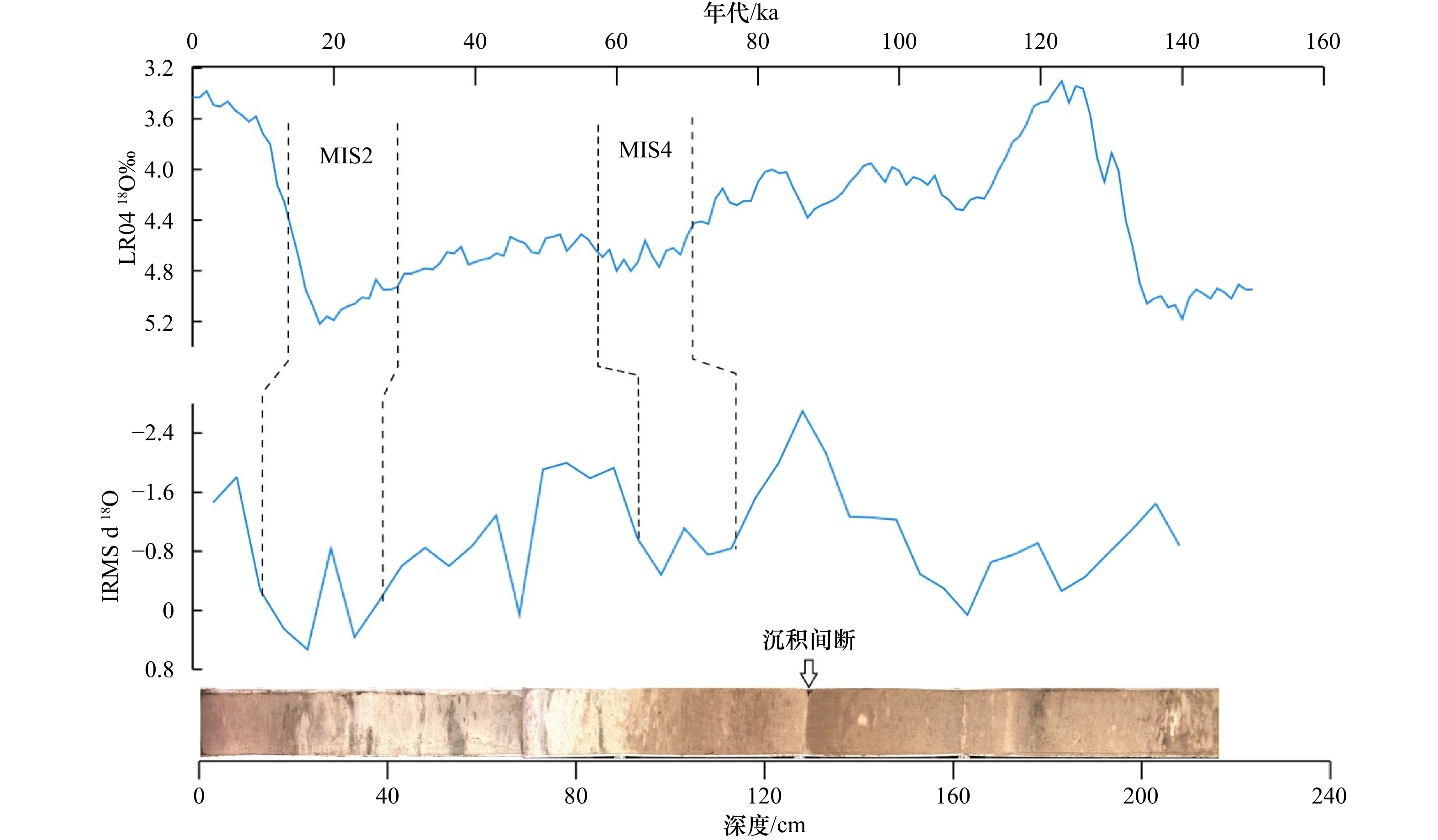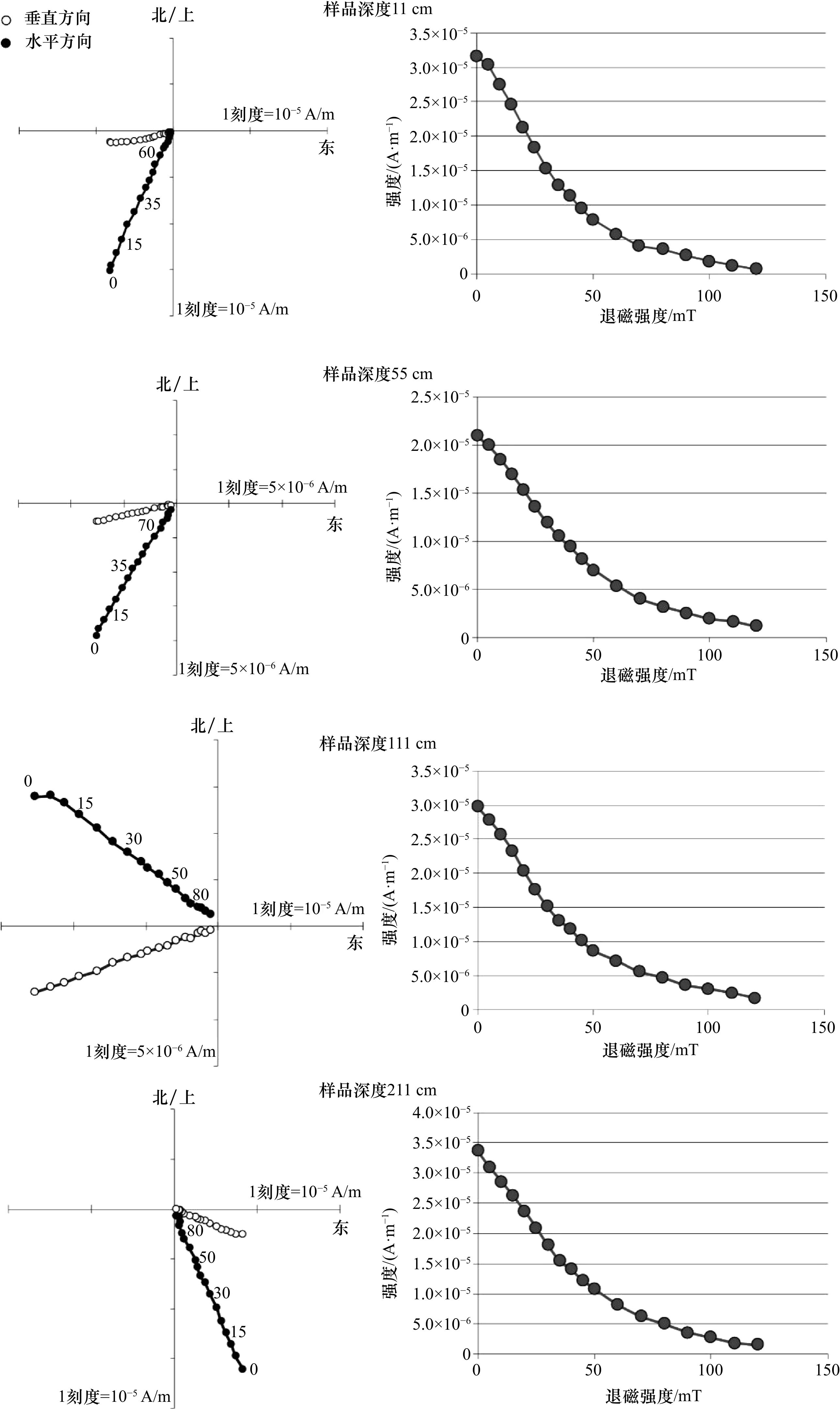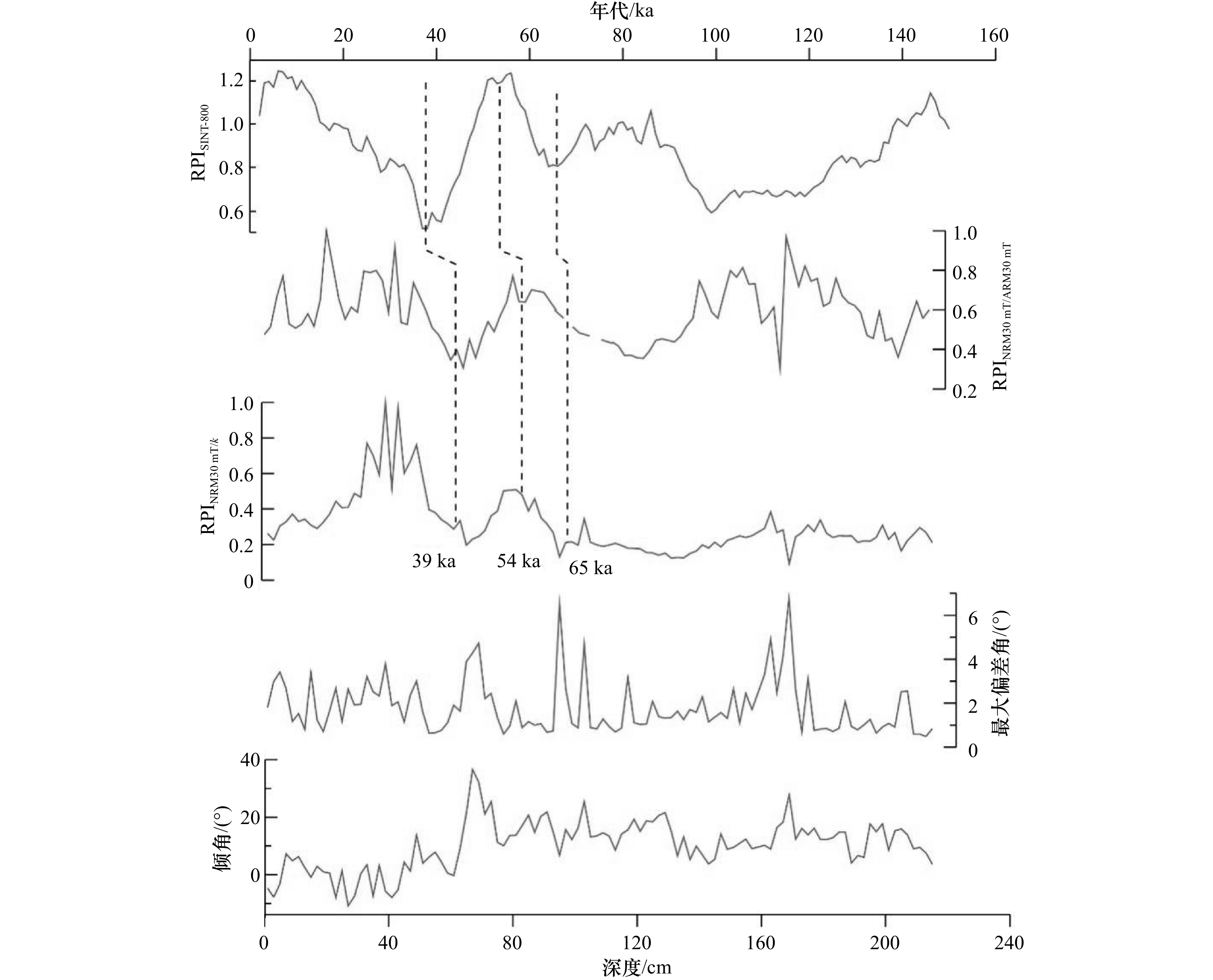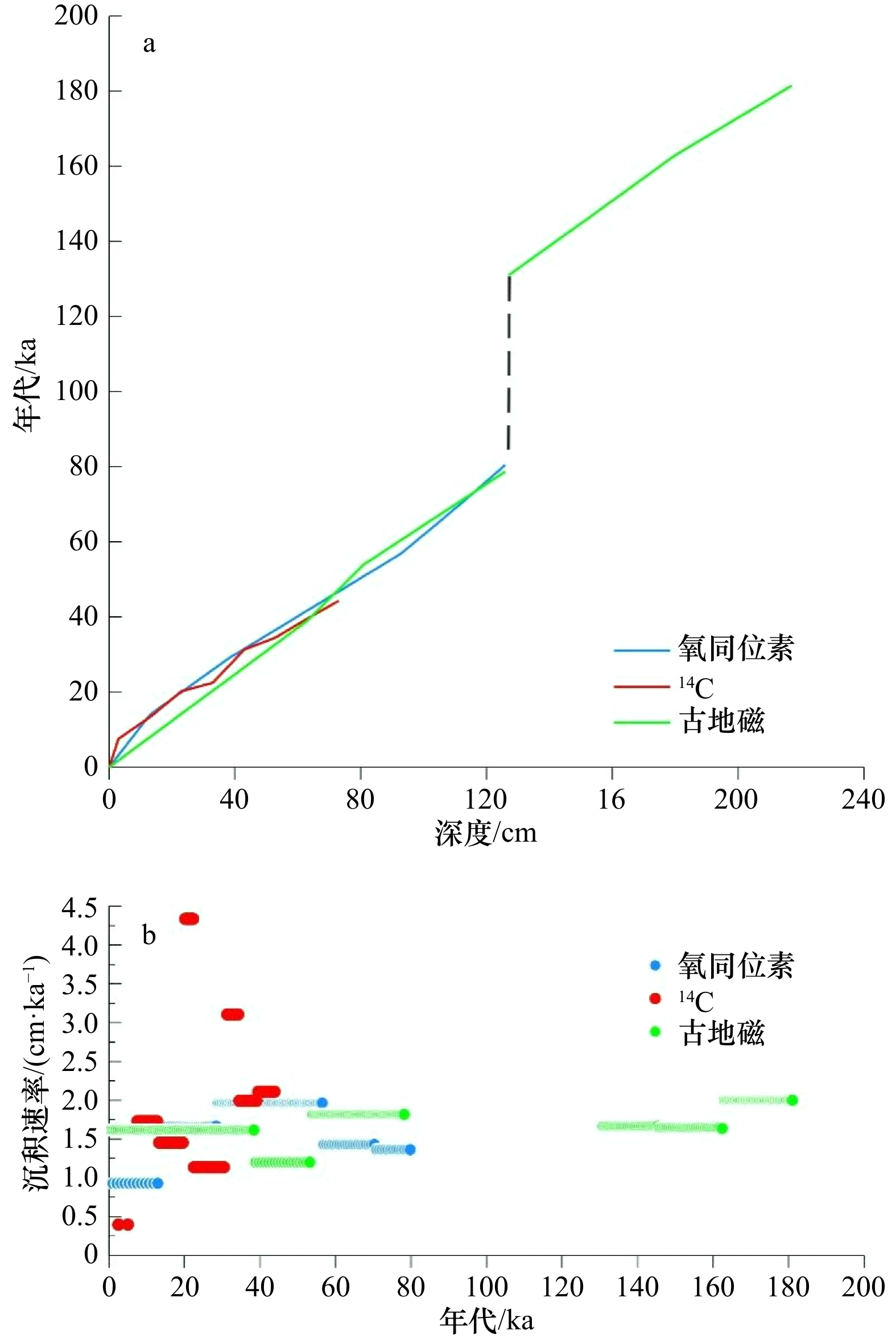Sedimentation rate obtained by multiple chronological analysis in Caroline area of the western Pacific Ocean
-
摘要: 为了更好地认识西太平洋暖池区北部卡罗琳海域沉积速率的变化,利用放射性碳测试(14C)、氧同位素及古地磁方法对采自西太平洋卡罗琳地区一根长217 cm的柱状样开展了综合年代学分析。14C数据获取了样品上部44.3 ka BP以来的年代数据,在此基础上利用氧同位素及古地磁相对强度数据建立了该柱125 cm至表层的年代框架,对应为MIS4期(约8万年)以来的沉积。进一步分析发现本柱在126~127 cm处存在明显沉积间断,虽然该处已超出14C测年范围,但古地磁测试结果表明该柱位于布容正极性时期,同时古地磁强度与氧同位素的变化关系为沉积间断以下年代数据获取提供了可信的证据,表明该阶段对应距今13万年至18万年时期。本柱沉积速率在沉积间断前后均较为一致,为1~2 cm/ka。同时对比不同方法获取的沉积速率之间差异后,发现个别层位可能由于较高的有孔虫破壳率,导致14C值存在较大偏差。Abstract: In order to better understand the sedimentary rate changes in the Caroline area which is located in the north of West Pacific Warm Pool, a comprehensive dating method was carried out by using radiocarbon testing(14C), oxygen isotope and paleomagnetism on a gravity core from the Caroline area of the western Pacific Ocean. 14C data provide the age of the upper section since 44.3 ka BP for this core. Subsequently, the age framework since MIS4 (about 80 ka) which corresponds to the depth of 125 cm was established by using oxygen isotope and relative paleointensity (RPI) data, while the upper part also considered the 14C data. Further analysis revealed that there was an obvious sedimentary discontinuity at the depth of 126 cm to 127 cm in this core, although it has been beyond the range of 14C dating, but the paleomagnetic results show that the core formed in Brunhes period, and the relationship between RPI and oxygen isotope data under the hiatus provide a robust evidence that the age is from 180 ka to 130 ka in the bottom. At the end the deposition rate of the core was obtained, which is 1 cm/ka to 2 cm/ka, and it is consistent before and after the deposition hiatus. At the same time, the disparity of the deposition rate for each dating method indicated that there was a large deviation of 14C data in one layer maybe due to the high rate of foraminiferal shell breaking.
-
Key words:
- 14C /
- oxygen isotope /
- paleomagnetic /
- sedimentation rate /
- western Pacific Ocean
-
图 4 古地磁倾角最大偏差角(MAD)及相对强度(RPI)变化图
RPINRM30 mT/ARM30 mT曲线中虚线部分(96~110 cm)由于样品原因,未获得ARM值,该层位年代值主要通过由k归一化的RPI获取
Fig. 4 The variation of magnetic inclination maximum angular deviation (MAD) and relative paleointensity (RPI)
The ARM value from 96 cm to 110 cm have not been got for the sample lost, where is dotted in RPINRM30 mT/ARM30 mT curve, and the age in this depth mainly obtained from the RPINRM30 mT/k curve
表 1 AMS14C测试及校对结果
Tab. 1 The testing and calibration result of AMS14C
深度/cm 惯用年龄/a BP 惯用年龄误差/a BP 校正年龄值/cal a BP 3 7 090 ±30 7 532 13 11 890 ±30 13 325 23 17 180 ±60 20 248 33 19 070 ±70 22 552 43 27 980 ±120 31 465 53 31 050 ±170 34 973 63 35 460 ±250 40 193 73 41 200 ±470 43 771 表 2 本柱年代框架数据
Tab. 2 Age frame data for this core
深度/cm 年代/ka 沉积速率/(cm·ka−1) 依据方法 备注 3 7.53 1.73 14C 13 13.33 1.44 14C 23 20.25 1.74 14C 33 26.00 1.83 氧同位素 43 31.47 2.85 14C 53 34.97 1.92 14C 63 40.19 2.79 14C 73 43.77 1.23 14C 83 51.91 1.96 氧同位素 93 57.00 1.43 氧同位素 103 64.00 1.43 氧同位素 113 71.00 1.36 氧同位素 126 80.53 — 氧同位素 沉积间断 127 131.00 1.67 RPI 132 134.00 1.67 RPI 152 146.00 1.65 RPI 180 163.00 2.00 RPI 210 178.00 2.00 RPI 217 181.50 RPI 注:− 表示未获得数据。 -
[1] 李保华, 赵泉鸿, 陈民本, 等. 南沙海区晚第四纪浮游有孔虫演化及其古海洋学意义[J]. 微体古生物学报, 2001, 18(1): 1−9. doi: 10.3969/j.issn.1000-0674.2001.01.001Li Baohua, Zhao Quanhong, Chen Minben, et al. Late Quaternary evolution of planktonic foraminifera in the southern South China Sea and their paleoceanographic significance[J]. Acta Micropalaeontologica Sinica, 2001, 18(1): 1−9. doi: 10.3969/j.issn.1000-0674.2001.01.001 [2] 汪品先, 闵秋宝, 卞云华, 等. 十三万年来南海北部陆坡的浮游有孔虫及其古海洋学意义[J]. 地质学报, 1986, 60(3): 215−225.Wang Pinxian, Min Qiubao, Bian Yunhua, et al. Planktonic foraminifera in the continental slope of the northern South China Sea during the last 130, 000 years and their paleo-oceanographic implications[J]. Acta Geologic Sinica, 1986, 60(3): 215−225. [3] 庄丽华, 常凤鸣, 李铁刚, 等. 南黄海EY02-2孔底栖有孔虫群落特征与全新世沉积速率[J]. 海洋地质与第四纪地质, 2002, 22(4): 7−14.Zhuang Lihua, Chang Fengming, Li Tiegang, et al. Foraminiferal faunas and Holocene sedimentation rates of core EY02-2 in the south Yellow Sea[J]. Marine Geology & Quaternary Geology, 2002, 22(4): 7−14. [4] 丁旋, 方念乔. 赤道西太平洋MD98-2182岩芯末次冰期以来的季风和厄尔尼诺事件记录[J]. 中国科学:地球科学, 2012, 55(10): 1706−1715. doi: 10.1007/s11430-012-4478-0Ding Xuan, Fang Nianqiao. The monsoon and El Niño events during the last glaciation as recorded in core MD98-2182 from the western equatorial Pacific Ocean[J]. Science China Earth Sciences, 2012, 55(10): 1706−1715. doi: 10.1007/s11430-012-4478-0 [5] Zhang Guoliang, Zhang Ji, Wang Shuai, et al. Geochemical and chronological constraints on the mantle plume origin of the Caroline Plateau[J]. Chemical Geology, 2020, 540: 119566. doi: 10.1016/j.chemgeo.2020.119566 [6] Johnson G C, Toole J M. Flow of deep and bottom waters in the Pacific at 10°N[J]. Deep-Sea Research Part I: Oceanographic Research Papers, 1993, 40(2): 371−394. doi: 10.1016/0967-0637(93)90009-R [7] 孟庆勇, 李安春, 李铁刚, 等. 西菲律宾海沉积物200 ka以来的地球磁场相对强度记录及其年代学意义[J]. 中国科学 D辑:地球科学, 2009, 52(8): 1115−1126. doi: 10.1007/s11430-009-0119-7Meng Qingyong, Li Anchun, Li Tiegang, et al. Relative paleointensity of the geomagnetic field during the past 200 ka from the West Philippine Sea and its chronological significance[J]. Science in China Series D: Earth Sciences, 2009, 52(8): 1115−1126. doi: 10.1007/s11430-009-0119-7 [8] 赵京涛. 热带西太平洋边缘晚第四纪以来的古环境研究[D]. 青岛: 中国科学院海洋研究所, 2007.Zhao Jingtao. Paleoenvironment evolution in the margin region of tropical western pacific during the late Quaternary[D]. Qingdao: The Institute of Oceanology, Chinese Academy of Sciences, 2007. [9] Kawahata H, Suzuki A, Ahagon N. Biogenic sediments in the West Caroline Basin, the western equatorial Pacific during the last 330, 000 years[J]. Marine Geology, 1998, 149(1/4): 155−176. [10] Stuiver M, Reimer P J, Reimer R W. CALIB 8.2[EB/OL]. [2021−08−21]. http://calib.org/calib/ [11] Heaton T J, Köhler P, Butzin M, et al. Marine20–the marine radiocarbon age calibration curve (0–55, 000 cal BP)[J]. Radiocarbon, 62(4): 779−820. [12] Sagnotti L. Demagnetization Analysis in Excel (DAIE). An open source workbook in Excel for viewing and analyzing demagnetization data from paleomagnetic discrete samples and u-channels[J]. Annals of Geophysics, 2013, 56(1): D0114. [13] Lisiecki L E, Raymo M E. A Pliocene-Pleistocene stack of 57 globally distributed benthic δ18O records[J]. Paleoceanography and Paleoclimatology, 2005, 20(1): PA1003. [14] Guyodo Y, Valet J P. Global changes in intensity of the Earth’s magnetic field during the past 800 kyr[J]. Nature, 1999, 399(6733): 249−252. doi: 10.1038/20420 [15] Mix A C, Ruddiman W F. Oxygen-isotope analyses and Pleistocene ice volumes[J]. Quaternary Research, 1984, 21(1): 1−20. doi: 10.1016/0033-5894(84)90085-1 [16] Shackleton N. Oxygen isotope analyses and Pleistocene temperatures re-assessed[J]. Nature, 1967, 215(5096): 15−17. doi: 10.1038/215015a0 [17] Cande S C, Kent D V. Revised calibration of the geomagnetic polarity timescale for the Late Cretaceous and Cenozoic[J]. Journal of Geophysical Research: Solid Earth, 1995, 100(B4): 6093−6095. doi: 10.1029/94JB03098 [18] Roberts A P, Tauxe L, Heslop D. Magnetic paleointensity stratigraphy and high-resolution Quaternary geochronology: successes and future challenges[J]. Quaternary Science Reviews, 2013, 61: 1−16. doi: 10.1016/j.quascirev.2012.10.036 [19] Tauxe L. Sedimentary records of relative paleointensity of the geomagnetic field: theory and practice[J]. Reviews of Geophysics, 1993, 31(3): 319−354. doi: 10.1029/93RG01771 [20] Guyodo Y, Valet J P. Relative variations in geomagnetic intensity from sedimentary records: the past 200, 000 years[J]. Earth and Planetary Science Letters, 1996, 143(1-4): 23−36. doi: 10.1016/0012-821X(96)00121-5 [21] Valet J P, Meynadier L, Guyodo Y. Geomagnetic dipole strength and reversal rate over the past two million years[J]. Nature, 2005, 435(7043): 802−805. doi: 10.1038/nature03674 [22] Néel L. Some theoretical aspects of rock-magnetism[J]. Advances in Physics, 1955, 4(14): 191−243. doi: 10.1080/00018735500101204 [23] Levi S, Banerjee S K. On the possibility of obtaining relative paleointensities from lake sediments[J]. Earth and Planetary Science Letters, 1976, 29(1): 219−226. doi: 10.1016/0012-821X(76)90042-X [24] 仇士华, 蔡莲珍. 14C测年技术新进展[J]. 第四纪研究, 1997, 17(3): 223−229.Qiu Shihua, Cai Lianzhen. Recent advancement in radiocarbon dating[J]. Quaternary Sciences, 1997, 17(3): 223−229. [25] 刘志杰, 余佳, 孙晓燕, 等. 海洋沉积物14C测年数据整合与校正问题探讨[J]. 第四纪研究, 2016, 36(2): 492−502. doi: 10.11928/j.issn.1001-7410.2016.02.24Liu Zhijie, Yu Jia, Sun Xiaoyan, et al. A discussion of marine sediments 14C data integration and correction[J]. Quaternary Sciences, 2016, 36(2): 492−502. doi: 10.11928/j.issn.1001-7410.2016.02.24 [26] Mekik F. Radiocarbon dating of planktonic foraminifer shells: a cautionary tale[J]. Paleoceanography and Paleoclimatology, 2014, 29(1): 13−29. [27] Barker S, Broecker W, Clark E, et al. Radiocarbon age offsets of foraminifera resulting from differential dissolution and fragmentation within the sedimentary bioturbated zone[J]. Paleoceanography and Paleoclimatology, 2007, 22(2): PA2205. [28] Lai Zhongping, Mischke S, Madsen D. Paleoenvironmental implications of new OSL dates on the formation of the “Shell Bar” in the Qaidam Basin, northeastern Qinghai-Tibetan Plateau[J]. Journal of Paleolimnology, 2014, 51(2): 197−210. doi: 10.1007/s10933-013-9710-1 [29] Reimer P J, Bard E, Bayliss A, et al. IntCal13 and Marine13 radiocarbon age calibration curves 0–50, 000 years cal BP[J]. Radiocarbon, 2013, 55(4): 1869−1887. doi: 10.2458/azu_js_rc.55.16947 [30] Stuiver M, Reimer P J, Bard E, et al. INTCAL98 radiocarbon age calibration, 24, 000–0 cal BP[J]. Radiocarbon, 1998, 40(3): 1041−1083. doi: 10.1017/S0033822200019123 -





 下载:
下载:





